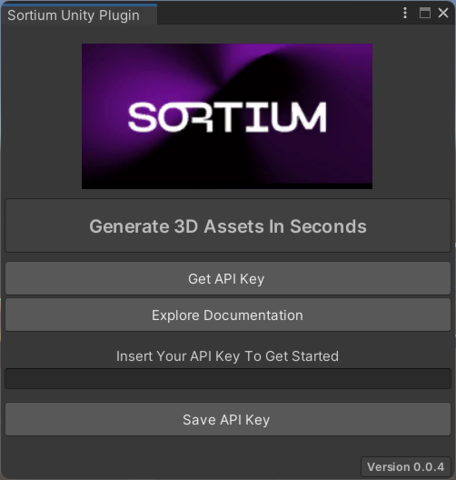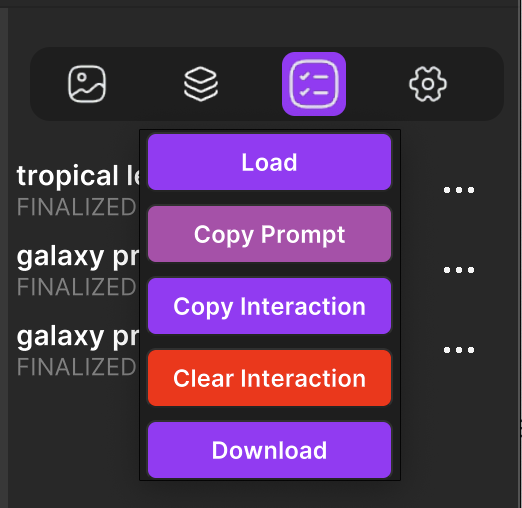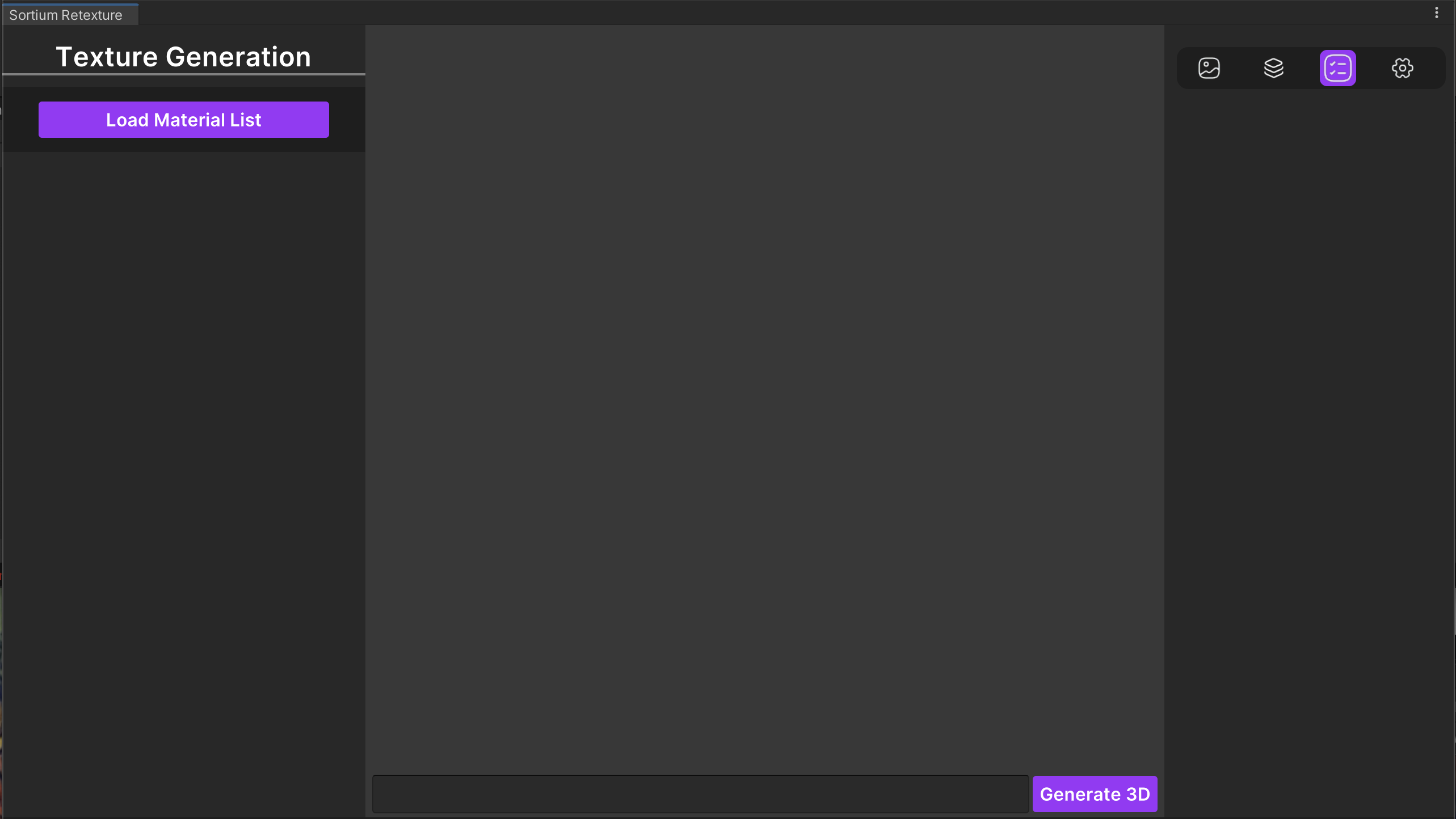Unity Plugin
Sortium Unity Plugin
A powerful addon for Unity that offers a comprehensive set of specialized tools designed to facilitate the creation of top-tier assets for 3D models. By seamlessly integrating with Sortium APIs, an advanced AI-powered asset creation platform, this plugin streamlines the asset creation and retexturing pipeline and helps users achieve visually stunning results. Whether you are involved in game development, gaming, or virtual production, the Sortium Unity Plugin is designed to enhance your workflows and deliver exceptional outcomes.
Plugin Setup
Before You Begin
Generating assets with Sortium requires an internet connection and an active subscription to our service. Subscriptions are available to suit a variety of budgets and use cases, including free plans. Visit app.sortium.com to create a free account and learn more about our other subscription options.
The following guide will help you set up the plugin within your Unity project. For best results, this plugin is officially verified and supported in Unity 2022.3.33f1 on Windows.
Installation From Zip
The plugin can be acquired as a Zip from Sortium. Contact us for more information.
- Download and extract the provided ZIP archive.
- Copy or move the Sortium folder directly into your Unity Project's Assets folder.
Installation from Unity Asset Store
- Locate the plugin in the Unity Asset Store and select
Add to My Assets. - From within your Unity project, navigate to the package manager from
Window > Package Managerwith your list filtered toPackages: My Assets - Select Sortium from the list and select
Import.
Unity glTFast
In order for the Sortium plugin to function correctly, you may need to also install the latest gLTfast
- In your Unity project, go to Windows > Package Manager.
- On the status bar, select the Add (+) button.
- From the Add menu, select Add + package by name. Name and Version fields appear.
- In the Name field, enter
com.unity.cloud.gltfast - Select
Add - The Editor installs the latest version of the package and any dependent packages.
- Make sure you have installed version 6.0.7 or higher of the GLTFast package.
For more information and resources, refer to the following:
Configuration
In the Unity Editor top bar, click on Tools, and select Tools > Sortium > Workspace from the editor menu.
Welcome Screen

Enter your Sortium user account's API Key credential in this field. This key is required to authenticate and access the Sortium backend services
Click Save API Key to get started. This setup is required only once if you haven't set your API Key previously.
You can clear an existing API Key if you wish under preferences in Edit > Project Settings > Sortium > Clear API Key.
Obtaining an API Key
To access and authenticate with the Sortium backend services, you will need to obtain an API Key. This key serves as your credential to access Sortium's powerful features and functionalities.
To get an API Key, please visit Sortium API Key Page and follow the instructions provided. Once you obtain the API Key, you can enter it in the api key field within Unity Project Settings window in Sortium section. This will enable seamless authentication and grant you access to Sortium's advanced asset creation and retexturing capabilities.
Please ensure that you keep your API Key secure and do not share it with unauthorized individuals. It is a vital component of accessing Sortium's services and maintaining the privacy and security of your account.
Other Plugin Settings
Additional plugin settings can also be found in Edit > Project Settings > Sortium
- Assets Folder → Set a desired assets folder path to be used by the plugin to import retexture asset process file results.
This folder must exist inside your Unity/Assets project folder. - Enable Logs → Use this toggle to enable Debug Mode. Once enabled, you can access and analyze logs directly within Unity's output logs interface, aiding in the debugging and optimization of your project.
- Clear API Key → This will remove the previously associated key from the plugin, allowing you to reconfigure it with a different API key.
Plugin Toolbox
Previews

Previews organizes your past 3D requests and resulting previews made across multiple sessions. You can use the panel to refer back to previous prompts and generate new assets.
Tasks

The Tasks panel contains all retexture and 3D requests for Sortium from your current session. When you make a new request, it is added to this panel section with its current status.
| Status | Info |
|---|---|
| Received | Task has been received by the queue but has not yet started. |
| Processing | System is actively working to generate the asset based on your input and prompts. |
| Processed | Asset is ready for viewing and further actions. |
| Finalized | Task is ready for viewing and assets are ready for downloading. |
| Error | Further action or investigation may be needed to address the failure. |
Library

The Asset Library stores and organizes your past retexture and 3D requests made across multiple sessions. You can use the library to refer back to previous prompts, review details, and make necessary modifications or updates.
Settings

Additional display settings are available for the plugin viewport.
- Mesh Info: toggling this on will display your current selected 3D asset's vertices and triangle/poly count.
- Grid: displays a grid background
- Background Color: adjusts the color seen in the viewport.
- Rotation: allows you to rotate the asset in the viewport.
- Light Intensity and Light Direction sliders adjust the lighting in the viewport.
Plugin Workflows
Retexture an Asset
For detailed information on how to retexture assets with Sortium and take advantage of all the available parameters, please check the tooltips or see our retexturing guide.
To use the Sortium Plugin for generating new procedural textures, follow the steps below:
-
Select the object in the scene that you want to retexture.
-
Open plugin window by clicking on Tools > Sortium.
-
Click
Load Materialsbutton. This action will generate a prompt parameters form interface to customize the retexture parameters according to your preferences in plugin's side menu containing specs for each material in the selected objects. -
Fill in the prompt parameters as desired for each material.
-
Once all the parameters are fulfilled as desired, click
Generate Texturebutton. -
The plugin will process the interaction and generate new textures based on the selected prompt parameters. The progress and results will be displayed in the
Taskspanel.
-
Finalized assets can be previewed by simply clicking on the task in the list.
-
If you want to clear all the prompt parameters and reset them to their default values, you can click the
Reset Defaultsbutton. -
After reviewing and confirming the resulting asset, you can add it to your scene by selecting
... > Loadon your chosen asset. The asset will be downloaded to the folder that has been selectedEdit > Project Settings > Sortium.

Generate a 3D asset
-
Begin with no objects selected in your scene and open the plugin window by clicking on Tools > Sortium > Generate.

-
Enter a descriptive prompt in the input field and click
Generate -
The plugin will process the interaction and generate 3 asset previews based on your prompt. The progress and results will be displayed in the
Taskspanel.
-
Select the finalized task from this panel to view your previews. From the previews you can now select which assets to
Generate, or selectRefreshto request new preview results.
-
Generations will also be processed as tasks and you can select them from this panel to view your finalized assets inside the plugin window.
-
After reviewing and confirming the resulting asset, you can select … > Download to download assets from your library into your project's Assets folder. Alternatively, you can choose to retexture this newly created asset by continuing with the Retexture Flow directly in the plugin window.
Troubleshooting
While setting up or using the Sortium Unity Plugin, you may encounter a few common issues. Here are some quick fixes to help resolve them:
Task List Stuck: Request Added but Not Processing
- Likely Cause: An issue with the API Key.
- Solution:
- Go to Edit > Project Settings > Sortium.
- Clear the API Key.
- Reopen the workspace and enter a new API Key when prompted.
Previously Generated Assets or Requests Missing from Previews or Asset Library
- Likely Cause: An issue with the API Key.
- Solution:
- Go to Edit > Project Settings > Sortium.
- Clear the API Key.
- Reopen the workspace and enter a new API Key when prompted.
Tasks Time Out, Fail, or Never Finalize
- Likely Cause: A temporary service disruption.
- Solution: Check the service status on our Status Page.
Pre-Existing Asset Not Displaying in the Workspace Viewport
- Likely Cause: Size or scaling issues, especially with assets optimized for other game engines using different measurement units.
- Solution:
- Reduce the scale of the asset in your scene.
- Reload the plugin workspace to ensure compatibility.
For more complex technical issues or further assistance, contact us via this form.
Resources
For more information and resources, refer to the following:
- Retexturing: Settings - Learn more about best practices for texture generation and recommended settings.
- Retexturing: UV Map Optimization - Learn more about how to optimize your 3D assets for best retexture results.
- Sortium - Visit Sortium website to learn more about the platform and its capabilities.
- Unity - Explore Unity documentation to understand its features and workflows.
Credits
The Sortium Unity Plugin is developed and maintained by the Sortium team.
Updated 4 months ago
